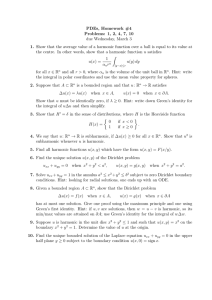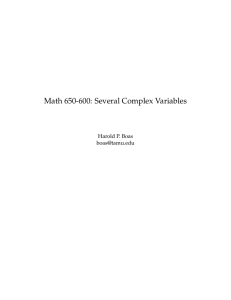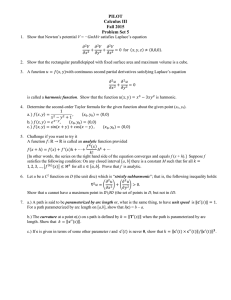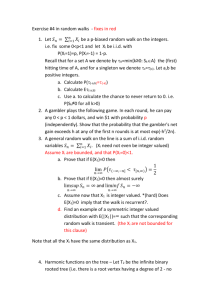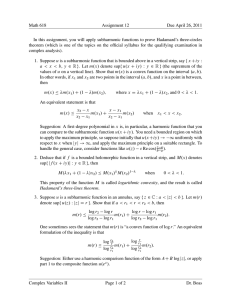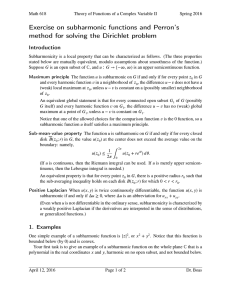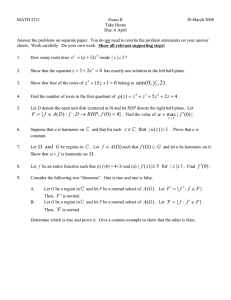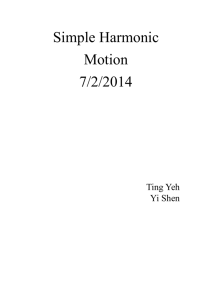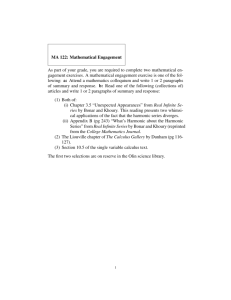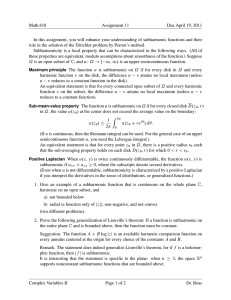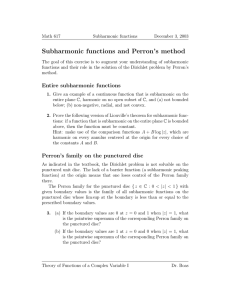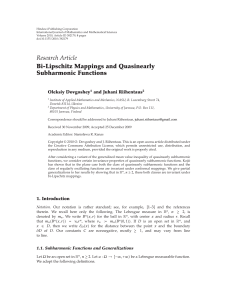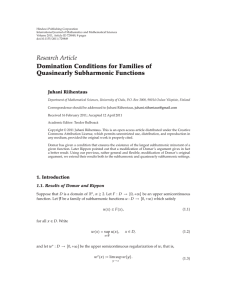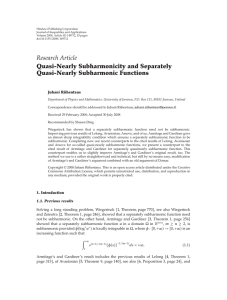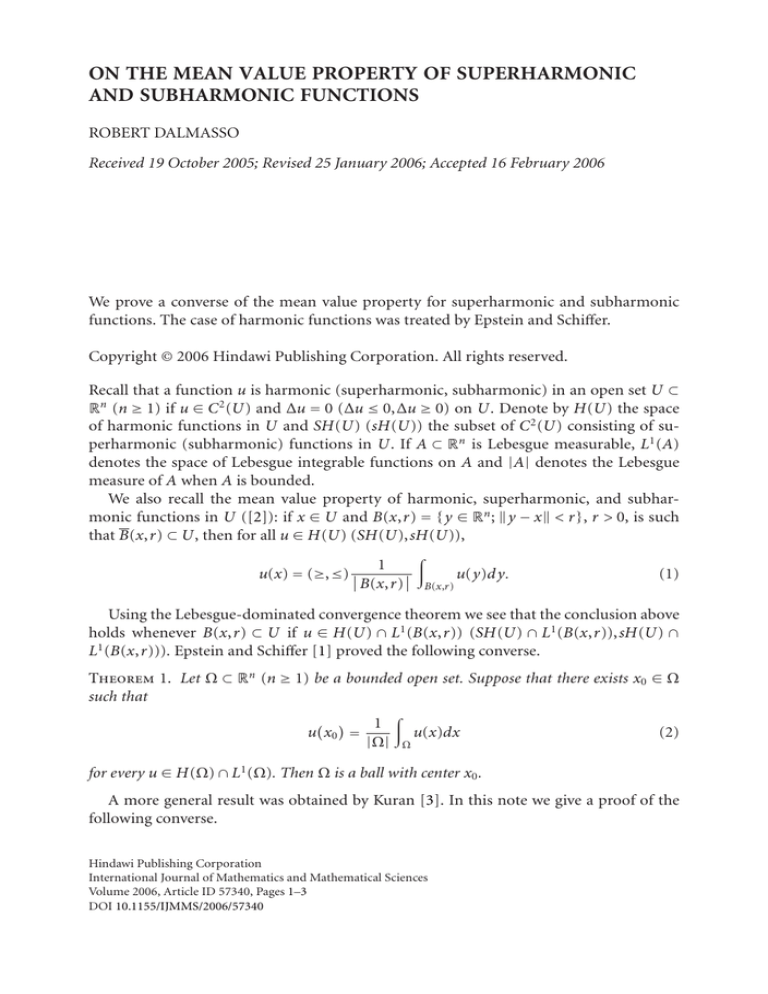
ON THE MEAN VALUE PROPERTY OF SUPERHARMONIC
AND SUBHARMONIC FUNCTIONS
ROBERT DALMASSO
Received 19 October 2005; Revised 25 January 2006; Accepted 16 February 2006
We prove a converse of the mean value property for superharmonic and subharmonic
functions. The case of harmonic functions was treated by Epstein and Schiffer.
Copyright © 2006 Hindawi Publishing Corporation. All rights reserved.
Recall that a function u is harmonic (superharmonic, subharmonic) in an open set U ⊂
Rn (n ≥ 1) if u ∈ C 2 (U) and Δu = 0 (Δu ≤ 0,Δu ≥ 0) on U. Denote by H(U) the space
of harmonic functions in U and SH(U) (sH(U)) the subset of C 2 (U) consisting of superharmonic (subharmonic) functions in U. If A ⊂ Rn is Lebesgue measurable, L1 (A)
denotes the space of Lebesgue integrable functions on A and |A| denotes the Lebesgue
measure of A when A is bounded.
We also recall the mean value property of harmonic, superharmonic, and subharmonic functions in U ([2]): if x ∈ U and B(x,r) = { y ∈ Rn ; y − x < r }, r > 0, is such
that B(x,r) ⊂ U, then for all u ∈ H(U) (SH(U),sH(U)),
1
u(x) = (≥, ≤) B(x,r)
B(x,r)
u(y)d y.
(1)
Using the Lebesgue-dominated convergence theorem we see that the conclusion above
holds whenever B(x,r) ⊂ U if u ∈ H(U) ∩ L1 (B(x,r)) (SH(U) ∩ L1 (B(x,r)),sH(U) ∩
L1 (B(x,r))). Epstein and Schiffer [1] proved the following converse.
Theorem 1. Let Ω ⊂ Rn (n ≥ 1) be a bounded open set. Suppose that there exists x0 ∈ Ω
such that
u x0 =
1
|Ω|
Ω
u(x)dx
(2)
for every u ∈ H(Ω) ∩ L1 (Ω). Then Ω is a ball with center x0 .
A more general result was obtained by Kuran [3]. In this note we give a proof of the
following converse.
Hindawi Publishing Corporation
International Journal of Mathematics and Mathematical Sciences
Volume 2006, Article ID 57340, Pages 1–3
DOI 10.1155/IJMMS/2006/57340
2
Mean value property of super (sub) harmonic functions
Theorem 2. Let Ω ⊂ Rn (n ≥ 1) be a bounded open set. Suppose that there exists x0 ∈ Ω
such that
u x0 ≥ (≤)
1
|Ω|
Ω
u(x)dx
(3)
for every u ∈ SH(Ω) ∩ L1 (Ω)\H(Ω) (sH(Ω) ∩ L1 (Ω)\H(Ω)) . Then Ω is a ball with center
x0 .
Proof. Clearly it is enough to consider the case of superharmonic functions. Since Ω is
bounded, there exists a largest open ball B centered at x0 of radius r1 which lies in Ω. The
compactness of ∂Ω implies that there is some x1 ∈ ∂Ω such that x1 − x0 = r1 . We will
show that Ω = B. Define
2
−n
h(x) = r1n−2 x − x0 − r12 x − x1 (4)
for x ∈ Rn \{x1 }. Then h ∈ H(Rn \{x1 }) and h(x0 ) = −1. Now let R > r1 be such that
Ω ⊂ B(x0 ,R). For k ∈ N∗ we set
uk (x) = 1 + h(x) +
2 1 2 R − x − x 0 ,
2nk
x ∈ Ω.
(5)
Obviously uk ∈ C 2 (Ω) and Δuk = −1/k in Ω, hence uk ∈ SH(Ω)\H(Ω). Moreover uk ∈
L1 (Ω) and uk (x) ≥ 1 for x ∈ Ω\B. Since 1 + h ∈ H(Ω) ∩ L1 (Ω), we have
0 = 1 + h x0 =
B
1 + h(x) dx.
(6)
Now using (6) we can write
1
1
1
R2
= uk x0 ≥
uk (x)dx =
uk (x)dx +
uk (x)dx
2nk
|Ω| Ω
|Ω| Ω\B
|Ω| B
2 1
1
=
uk (x)dx +
R2 − x − x0 dx
|Ω| Ω\B
2nk|Ω| B
|Ω\B |
ωn r1n R2
r12
≥
+
−
|Ω|
2nk|Ω| n n + 2
|Ω\B |
ωn r1n R2
r12
+
−
≥
|Ω|
2nk|Ω| n n + 2
(7)
for all k ∈ N∗ , where ωn denotes the measure of the unit sphere in Rn . This implies that
|Ω\B | = 0. Then the open set Ω\B must be empty, hence Ω ⊂ B. Since Ω is open and
B ⊂ Ω ⊂ B, we deduce that Ω = B.
References
[1] B. Epstein and M. Schiffer, On the mean-value property of harmonic functions, Journal d’Analyse
Mathématique 14 (1965), 109–111.
[2] D. Gilbarg and N. S. Trudinger, Elliptic Partial Differential Equations of Second Order,
Grundlehren der Mathematischen Wissenschaften, vol. 224, Springer, Berlin, 1977.
Robert Dalmasso 3
[3] Ü. Kuran, On the mean-value property of harmonic functions, The Bulletin of the London Mathematical Society 4 (1972), 311–312.
Robert Dalmasso: Laboratoire LMC-IMAG, Equipe EDP, Tour IRMA, BP 53,
38041 Grenoble Cedex 9, France
E-mail address: robert.dalmasso@imag.fr


